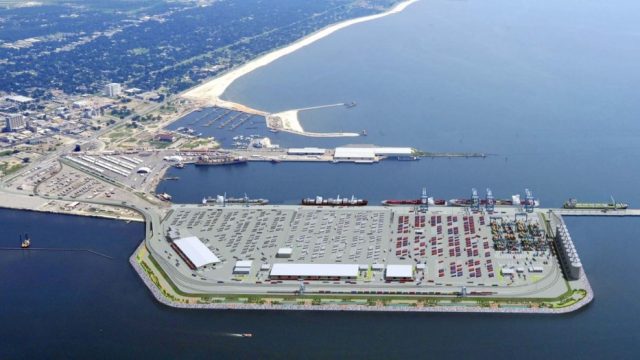Gulfport likely won’t get major seaport status, expert says

SLOW PACE: Despite receiving $560 million in federal funds from Housing and Urban Development, the port of Gulfport’s expansion won’t be complete until 2016.
By Steve Wilson | Mississippi Watchdog
Efforts to turn the Port of Gulfport into a major seaport are doomed to failure, according to maritime expert Tim Colton.
Colton, a maritime consultant, naval architect and former shipbuilding executive who runs the Maritime Memos website, said there are too many factors at play against Gulfport.
“The whole concept of turning Gulfport into a major port is ridiculous,” Colton said. “No rational shipowner looks at Gulfport and sees an alternative to Mobile or New Orleans. Mobile and New Orleans have been major ports for centuries. Gulfport is nothing.”
The numbers back up his assertion. Last year, the port handled more than 2 million tons of cargo, nearly back to pre-Katrina levels. From 2010-12, the Port of New Orleans handled a yearly average of 31 million tons. In 2012, the Alabama State Docks in Mobile handled 6.2 million tons of cargo.
According to its post-renovation goals, the port wants to expand from more than 202,000 20-foot equivalent units (TEUs) of cargo in 2012 to 1,000,000 TEUs by the time the expansion is complete. Those numbers will shrink when Chiquita, one of its major tenants, leaves for New Orleans in 2015. The fruit company shipped 635,000 tons of cargo through the port last year and employed 20 permanent workers.
The port received $581 million from the U.S. Department of Housing and Urban Development after Hurricane Katrina for repair and renovations. The renovation work is still ongoing and won’t be complete until 2016, 11 years after Katrina hit.
According to the state’s agreement with HUD, the port was supposed to maintain 1,300 jobs and add 1,300 more when the project was complete. However, a report by the state shows the port is falling short of its job creation goals, with only 814 employed there. The addition of McDermott International’s new spoolbase pipe fabrication facility to the port will add 100 permanent jobs.
“This money came into the Port of Gulfport with little comment and little information,” said Howard Page, the port campaign coordinator for the Steps Coalition. “They’ve never been able to get their facts straight on the number of jobs there. When government tends to get involved in a project, they tend to make bad choices.”
Despite the huge federal investment, the port will have a difficult time competing with its neighbors to the west (New Orleans) and east (Mobile). Colton cited the lack of large-scale road and rail infrastructure designed to move thousands of tons of cargo inland as one of several reasons why the port suffers in comparison to its competition.
The rail lines connected to the port were recently upgraded with state funds and allow the double-stacking of containers, but the primary road northward out of the port is the city’s busiest road, U.S. 49. The Mississippi Department of Transportation estimated 58,000 cars every 48 hours travel on the road, according to its last traffic counter data from 2012.
The channel’s depth of 36 feet is also inadequate, Colton said. Panamax cargo ships, which can fit through the locks of the Panama Canal and are considered mid-sized by the shipping industry with a cargo capacity of 5,000 TEUs, need a channel depth of 41.5 feet. The New Panamax vessels, designed to carry more cargo (13,000 TEUs) through an expanded canal, need 49.9 feet.
Also, the port’s location, which juts into the Mississippi Sound, isn’t ideal either.
“To be a big port, you’ve got to have 45 feet (depth) and preferably 50,” Colton said. “And dredging is not as easy as they make it sound. It can’t grow to the east or the west, so it must build out into the gulf. It’s more vulnerable to storms than almost any port in the country.”
Contact Steve Wilson at swilson@watchdog.org
Get regular updates on Mississippi through our Facebook or Twitter accounts







